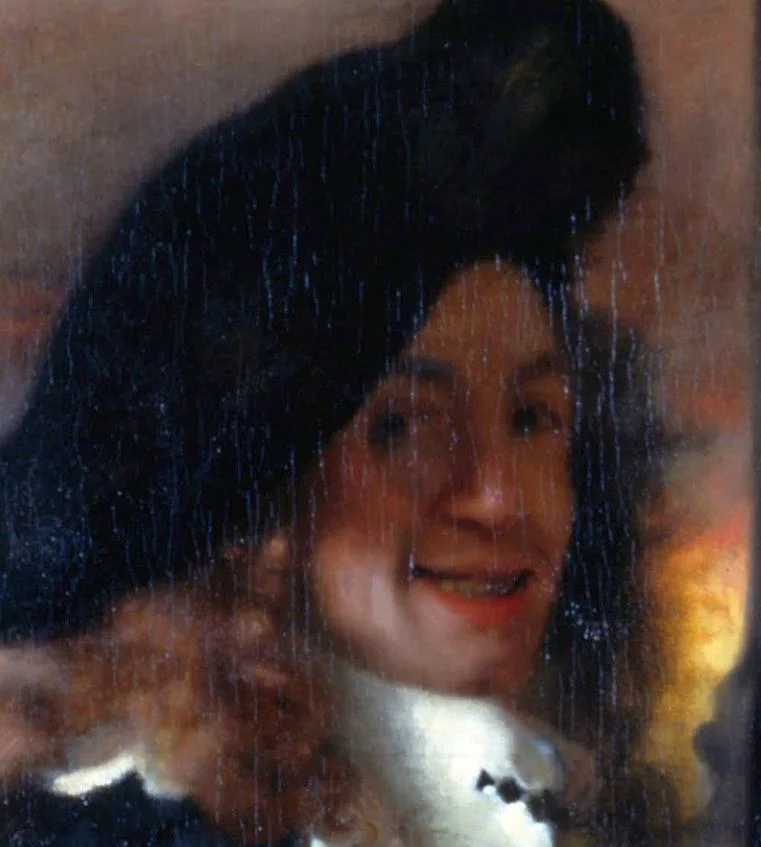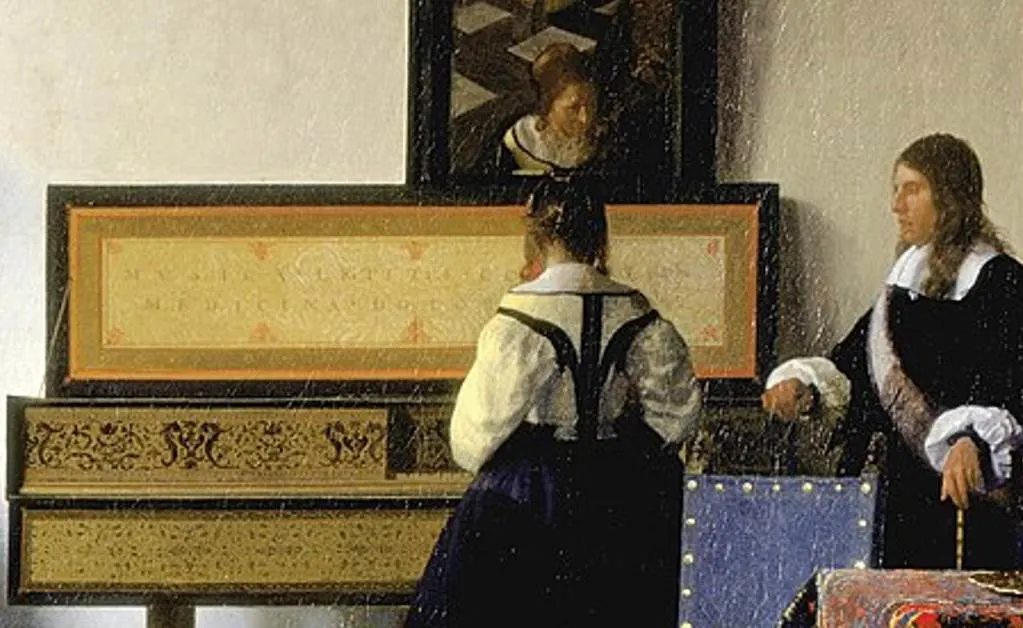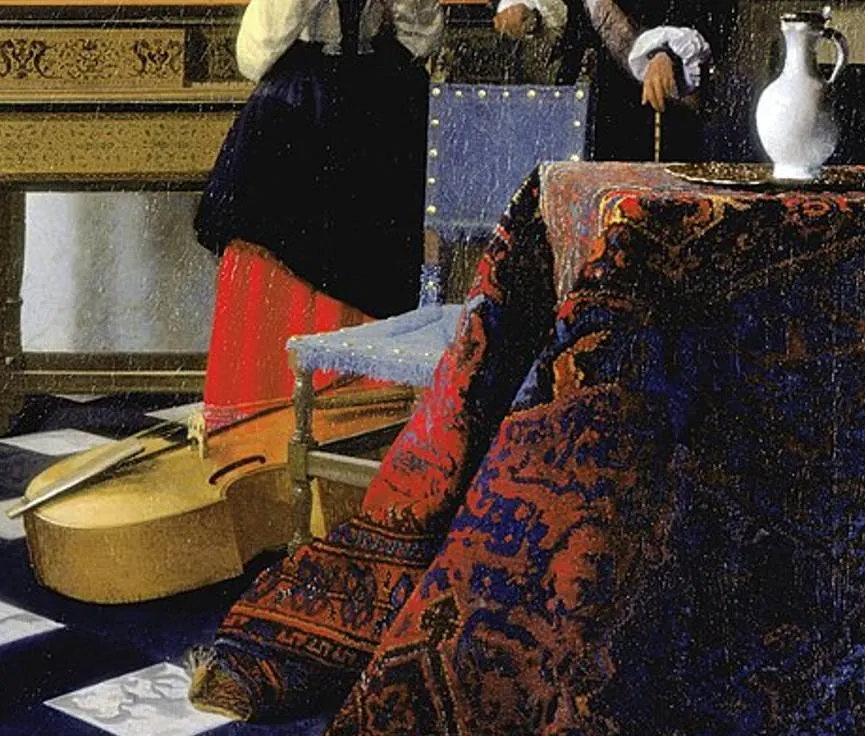Most of the paintings by Vermeer, the famous Dutch artist who lived during the Dutch Golden Age in the 17th century, depict a scene inside his own house.
This painting is no different and depicts items we can admire in some of his other works as well.
Let’s take a closer look at some of the most interesting facts about The Music Lesson by Johannes Vermeer (1632-1675), a remarkable work of art by the Baroque artist for multiple reasons.
1. It was probably painted in the first half of the 1660s
Dutch artist of the Baroque era Johannes Vermeer solely dedicated himself to his art. He became a member of the Guild of Saint Luke in Delft in the year 1653 and married a Catholic woman that same year.
He and his wife Catharina Bolenes moved into the house of her mother in his native city and this is where he painted the vast majority of his works.
The problem with Vermeer’s paintings is that he rarely signed and dated them. This makes it a bit complicated to know exactly when each painting was completed.
It’s clear that he already reached his maturity as a master when he produced The Music Lesson so art historians estimate that he completed it anywhere between 1662 and 1665.

2. The painting goes by a couple of other names
This painting is commonly referred to as “The Music Lesson” because a man and woman can be seen playing music.
The man’s mouth is slightly gaping which makes us assume he is singing to the music played by the girl at a Virginal. This is a type of keyboard instrument that was popular during the late Renaissance and Baroque eras.

The other titles of the work are even more descriptive as the painting is also known as “Woman Seated at a Virginal” and “A Lady at the Virginal with a Gentleman.”

3. There’s an interesting inscription on the lid of the virginal
The woman is sitting with her back facing the viewer which is a somewhat odd position. Vermeer added a mirror to the wall so we can see her face.
Equally interesting is the inscription on the virginal that reads:
MUSICA LETITIAE CO[ME]S / MEDICINA DOLOR[IS]
This translates to “Music is a companion in pleasure and a balm in sorrow” ad has been interpreted as the artist implying a romantic relationship between the man and woman.
There aren’t any other clues as to the exact relationship between the two so we can only guess. This notion only adds mystery to the intriguing scene.

4. Most of the elements in this painting appear in some of his other works
Vermeer’s mother-in-law, a woman named Maria Thins (1593-1680), was much wealthier than the artist himself.
She lived in a large house that could serve as a residence for his growing family as well. Many of the items in Vermeer’s paintings are her possessions and indicate that she was a member of the upper class.
The rug on the table, the white water jug, the musical instruments on the floor, and the tiled floor all look very familiar as they appear in various other paintings by the artist.
The overall composition with a window to the left which serves as the main source of light is also similar to his other works. This allowed him to fully exploit his mastery of light and shadow which make his works such masterpieces.

5. It was one of the paintings in Vermeer’s collection when he passed away
The painting never left the personal collection of the artist and was one of the works that were sold in Delft in 1696.
The end of the Dutch Golden Age was caused by political turmoil and war, including the Franco-Dutch War and the War of the Spanish Succession.
This was a devastating blow for many artists as commissions ran dry. Vermeer’s widow was one of the people that was left in debt due to the economic climate at the time.
This particular painting was sold in Delft in 1696 and acquired by Jacob Dissius. He owned a total of 21 Vermeer paintings in the late 17th century, including masterpieces such as “The Milkmaid” and “Woman Holding a Balance.”

6. The painting wasn’t identified as the artist’s until the 19th century
The painting was acquired by a Venetian artist named Giovanni Antonio Pellegrini (1675-1741) in 1718. From Venice, it eventually made its way to England.
The painting was signed by Vermeer as IVMeer but this was misinterpreted in the 18th century. It was therefore considered to be a work by another Dutch Golden Age painter named Frans van Mieris the Elder (1635-1681).
It wasn’t until Théophile Thoré-Bürger (1807-1869- completed his catalog of Vermeer paintings in the year 1866 that it was correctly attributed to the artist.

7. How big is The Music Lesson by Johannes Vermeer?
Johannes Vermeer worked extremely slowly. This meant that it took him several months to complete relatively small paintings, including this one.
The Music Lesson by Vermeer is an oil on canvas painting that has dimensions of 74.6 × 64.1 centimeters (29.4 × 25.2 inches). This is medium-sized compared to his other works.
8. Where is the painting located today?
Pellegrini’s collection was bought in Venice by Joseph Smith, the British Consul of Venice between 1744 and 1760.
His collection was in turn purchased by King George III (1738-1820) in 1762, which is the year that it entered the Royal Collection.
It has been housed at Windsor Castle and Buckingham Castle throughout its history. It’s currently on display at the Queen’s Gallery in London, which is the main public gallery of Buckingham Palace.

